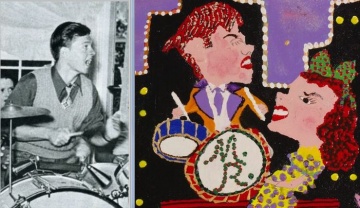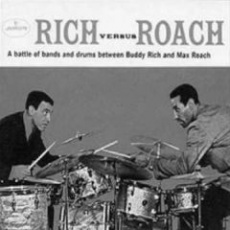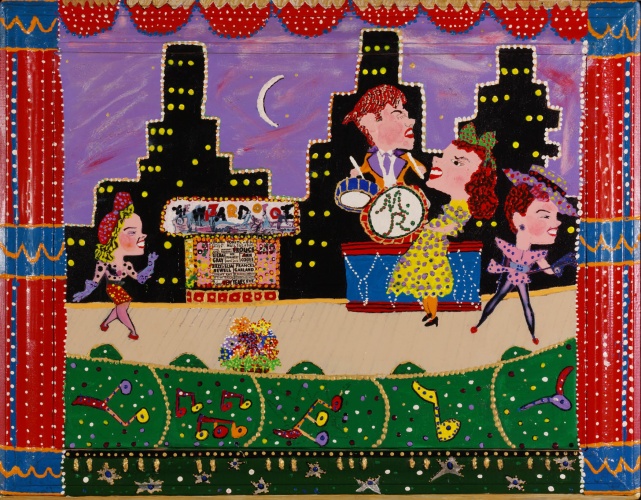The Wizard of Oz
- 1992
- Acrylic Gel
- 29" x 23"
If she hadn’t put it on the kiosk, complete with an old poster referencing Frances Garland, who was born Frances Gumm and later became Judy Garland, we might never have associated The Wizard of Oz with anything going on here. But Harriet Young did put it on the kiosk, and this in turn allows for an easy connection with one of the women on stage in this Las Vegas Christmas cabaret, who has to be Judy Garland. But there are two other women on stage, so right away there is a mystery to deal with. And then there is M.R., the wincing drummer. Like the women, M.R. has a very large HEAD, suggesting that at some level this is a tale about heads, or better yet what’s inside them.
The solution to the three women mystery is a humbling reminder that, at least for some of us, it doesn’t take much to put a crimp in our ability to see. In The Wizard of Oz Harriet has fooled us with a “triple head fake”. Three female heads atop three female bodies depicts three different females. That’s how it works walking down the street in real life. But this is not real life, it’s a canvas, and a clear, focused look at the women reveals that they are ALL Judy Garland. Harriet goes out of her way to avoid cloning, but the resulting differences are superficial and presented in profile, making for easy comparisons and allowing us to conclude that we are indeed looking at three depictions of the same person.
Regarding our drummer, there was no on-screen drummer in The Wizard of Oz. So how did he wind up on stage, complete with a drum kit bearing the initials M.R.?
As a teenager Judy Garland made a series of movies with Mickey Rooney, including at least one where he played drums in back of her. In 1937, the earliest Rooney/Garland movie release year, Harriet Young was an impressionable seven-year-old.
Whatever else the composite image below fails to explain, the presence of Rooney and Garland together on screen and the likeness of Rooney’s clothes and position in the fanzine compared to what Harriet painted is enough to establish the early Judy Garland-Mickey Rooney movies as the inspiration for our drummer.

At this point it would not be unreasonable to conclude that the question of who is being depicted in this painting has been answered. If one accepts this, then the painting is just an offbeat, roundabout tribute to Judy Garland, who in real life was complicated enough to merit several diverse personae milling about on canvas, say in the form of an innocent girl from Kansas, a dominatrix, and a groovin’-to-the-beat blonde.
But there is a problem here. Why does Harriet’s drummer have a flat head and wiry hair when Mickey Rooney had a round head and straight hair? This is for certain a deliberate act, not sloppy work. Our best guess is that she probably had someone else in mind:

The drummer depicted in the painting is the flat-headed, wiry-haired Buddy Rich, or so we would assert, and like Judy Garland he was plenty complicated himself. In the album cover above he is on the left, directly across from the greatest jazz drummer on the planet with the initials M.R. (or possibly any other initials), Max Roach.
In depicting Judy Garland, Harriet took one woman and gave her three embodiments. In depicting M.R., she took three men and gave them one embodiment. As other paintings in this collection suggest, Harriet was a serial multiple-sourcer and identity-obscurer. Psychoanalysts, start your engines.
Of course it was just a coincidence that the initials M.R. matched both Mickey Rooney and Max Roach, but we’ll speculate that once Harriet saw it as a way to make trouble she gleefully latched onto it, switching out of 4/4 into 9/8 and causing us to trip over our own feet decades later trying to deconstruct it.
Finally, we note that in 1966 Sammy Davis Jr. and Buddy Rich released an album culled from a series of live performances at the Las Vegas Sands – performances Harriet might actually have seen on a night out or as a hostess. The album is entitled The Sounds of ’66, and for our purposes here is the song that matters:
(listen to Sammy&Buddy on youtube.)
Ding Dong the Witch Is Dead is a musical mainstay of The Wizard of Oz.
